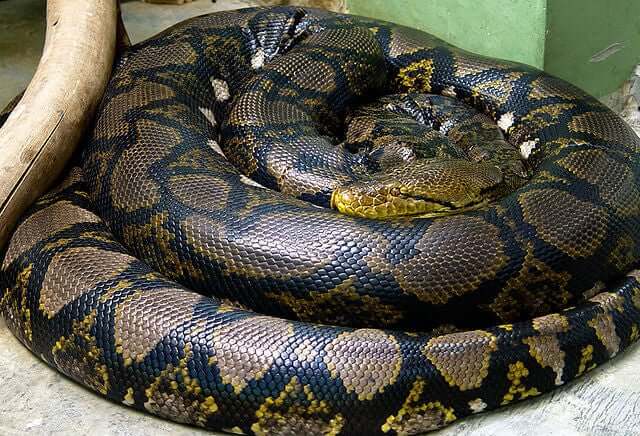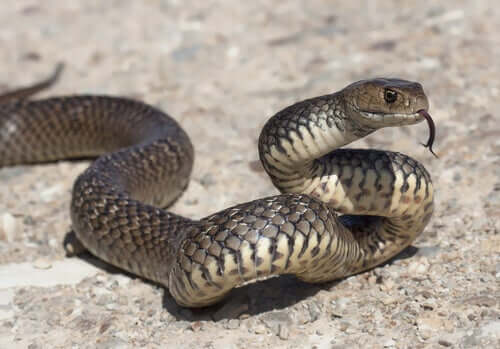Snakeskin Shedding Problems


Written and verified by the vet Eugenio Fernández Suárez
Snakeskin shedding is a process where snakes change their skin, particularly when growing, although they also do it throughout their lives. Snakes will shed their skin from time to time depending on many factors, such as species, diet or state of health. Part of basic care for a snake is knowing how to properly look after your snake during the shed.
What is snakeskin shedding?
During the shedding process, the snake will be more elusive or even aggressive if you insist on handling them. This is mainly because their vision gets considerably worse. During the shedding process, they’ll stop eating, so you’ll normally have to wait until after they have completely shed their skin before feeding them.

Shedding will start from the nose and move down towards the tail and the snake will need to rub against things in its enclosure to aid the process. Their skin will become paler and their eyes will become whiter as well as losing their shine.
This process is normally clean and complete, allowing the skin the renew completely. However, some pieces of dead skin may remain stuck to the snake’s body. If this happens, we call it a ‘retained shed’. This is one of the most common skin problems with snakes.
This process is normally clean and complete, allowing the skin the renew completely. However, some pieces of dead skin may remain stuck to the snake’s body.
Causes of retained shed
A retained shed can be caused by several reasons. It’s important to keep the right humidity in the enclosure according to the species of snake that you have. This is especially important if you live in a dry climate.
Snakeskin shedding problems may also be caused by an underlying illness. This is normally a skin disease, such as external parasites, dermatitis, wounds, etc. Another possibility is a nutritional problem where your snake isn’t getting the necessary vitamins or nutrients.
It’s important to keep the right humidity in the terrarium according to the species of snake that you have. This is especially important if you live in a dry climate.

Treating a retained shed
Although final treatment should be carried out by a vet, you can improve your snake’s hydration, which is the most common cause of a retained shed. To do this, you can use a humidifier, especially if the enclosure provides you with humidity measurements and you know what the ideal humidity is for your species of snake.
We also recommend using substrates that retain water and making sure that there is plenty of water in the enclosure. You can also use a water spray filled with warm water to give them a spray bath when you remove them from their tank. When handling them, it’s very important to try not to tear the skin.
One of the most sensitive areas for a retained shed is the eye, and it can lead to blindness if you can’t get the shed to finish or if you try to remove it by force. The best remedy is to get some eye drops prescribed by your vet.
As we already mentioned, skin diseases and nutritional problems are other possible causes of a retained shed. You should start to get suspicious if the problem persists even after improving the humidity of their enclosure. Regardless of the case, make sure you choose a vet who has experience with snakes to help you.
Even if your snake doesn’t have any snakeskin shedding problems, they can occur for other reasons. This is why it’s important to always make sure that your snake has access to water and plenty of rough surfaces to allow them to shed properly.
Snakeskin shedding is a process where snakes change their skin, particularly when growing, although they also do it throughout their lives. Snakes will shed their skin from time to time depending on many factors, such as species, diet or state of health. Part of basic care for a snake is knowing how to properly look after your snake during the shed.
What is snakeskin shedding?
During the shedding process, the snake will be more elusive or even aggressive if you insist on handling them. This is mainly because their vision gets considerably worse. During the shedding process, they’ll stop eating, so you’ll normally have to wait until after they have completely shed their skin before feeding them.

Shedding will start from the nose and move down towards the tail and the snake will need to rub against things in its enclosure to aid the process. Their skin will become paler and their eyes will become whiter as well as losing their shine.
This process is normally clean and complete, allowing the skin the renew completely. However, some pieces of dead skin may remain stuck to the snake’s body. If this happens, we call it a ‘retained shed’. This is one of the most common skin problems with snakes.
This process is normally clean and complete, allowing the skin the renew completely. However, some pieces of dead skin may remain stuck to the snake’s body.
Causes of retained shed
A retained shed can be caused by several reasons. It’s important to keep the right humidity in the enclosure according to the species of snake that you have. This is especially important if you live in a dry climate.
Snakeskin shedding problems may also be caused by an underlying illness. This is normally a skin disease, such as external parasites, dermatitis, wounds, etc. Another possibility is a nutritional problem where your snake isn’t getting the necessary vitamins or nutrients.
It’s important to keep the right humidity in the terrarium according to the species of snake that you have. This is especially important if you live in a dry climate.

Treating a retained shed
Although final treatment should be carried out by a vet, you can improve your snake’s hydration, which is the most common cause of a retained shed. To do this, you can use a humidifier, especially if the enclosure provides you with humidity measurements and you know what the ideal humidity is for your species of snake.
We also recommend using substrates that retain water and making sure that there is plenty of water in the enclosure. You can also use a water spray filled with warm water to give them a spray bath when you remove them from their tank. When handling them, it’s very important to try not to tear the skin.
One of the most sensitive areas for a retained shed is the eye, and it can lead to blindness if you can’t get the shed to finish or if you try to remove it by force. The best remedy is to get some eye drops prescribed by your vet.
As we already mentioned, skin diseases and nutritional problems are other possible causes of a retained shed. You should start to get suspicious if the problem persists even after improving the humidity of their enclosure. Regardless of the case, make sure you choose a vet who has experience with snakes to help you.
Even if your snake doesn’t have any snakeskin shedding problems, they can occur for other reasons. This is why it’s important to always make sure that your snake has access to water and plenty of rough surfaces to allow them to shed properly.
This text is provided for informational purposes only and does not replace consultation with a professional. If in doubt, consult your specialist.







